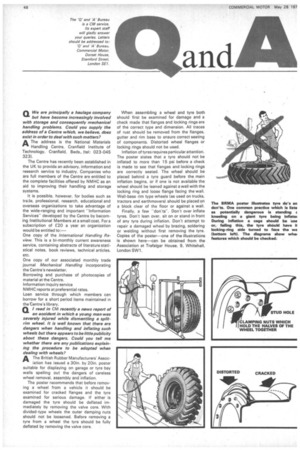and
Page 56

If you've noticed an error in this article please click here to report it so we can fix it.
Commercial Motor, Dorset House, Stamford Street, London SD'.
QWe are principally a haulage company but have become increasingly involved with storage and consequently mechanical handling problems. Could you supply the address of a Centre which, we believe, does exist in order to deal with such matters? AThe address is the National Materials Handling Centre, Cranfield Institute of Technology, Cranfieid, Beds. (tel: 023-045 323).
The Centre has recently been established in the UK to provide an advisory, information and research service to industry. Companies who are full members of the Centre are entitled to the completefacilities offered by NM He as an aid to improving their handling and storage systems.
It is possible, however, for bodies such as trade, professional, research, educational and overseas organizations to take advantage of the wide-ranging and important "Information Services" developed by the Centre by becoming Institutional Members at a small cost. For a subscription of £20 a year an organization would be entitled to:—
One copy of the International Handling Review. This is a bi-monthly current awareness service, containing abstracts of literature statistical notes, book reviews, technical articles, etc.
One copy of our associated monthly trade journal Mechanical Handling incorporating the Centre's newsletter.
Borrowing and purchase of photocopies of material at the Centre.
Information inquiry service NM HC reports at preferential rates.
Loan service through which members can borrow for a short period items maintained in theCentre's library.
QI read in CM recently a news report of
an accident in which a young man was severely injured while dismantling a splitrim wheel. It is well known that there are dangers when handling and inflating such wheels but there appears to be little publicity about these dangers. Could you tell me whether there are any publications explaining the procedure to be adopted when dealing with wheels?
AThe British Rubber Manufacturers' Assoc
iation has issued a 30in, by 20in. poster suitable for displaying on garage or tyre bay walls spelling out the dangers of careless wheel removal, assembly and inflation.
The poster recommends that before removing a wheel from a vehicle it should be examined for cracked flanges and the tyre examined for serious damage. If either is damaged the tyre should be deflated immediately by removing the valve core. With divided-type wheels the outer damping nuts should not be loosened. Before removing a tyre from a wheel the tyre should be fully deflated by removing the valve core. When assembling a wheel and tyre both should first be examined for damage and a check made that flanges and locking rings are of the correct type and dimension. All traces of rust should be removed from the flanges, gutter and rim base to ensure correct seating of components. Distorted wheel flanges or locking rings should not be used.
Inflation of tyres requires particular attention. The poster states that a tyre should not be inflated to more than 15 psi before a check is made to see that flanges and locking rings are correctly seated. The wheel should be placed behind a tyre guard before the main inflation begins, or if one is not available the wheel should be leaned against a wall with the locking ring and loose flange facing the wall. Well-base rim type wheels (as used on trucks, tractors and earthmovers) should be placed on a block clear of the floor or against a wall.
Finally, a few "don'ts-. Don't over inflate tyres. Don't lean over, sit on or stand in front of any tyre during inflation. Don't attempt to repair a damaged wheel by brazing, soldering or welding without first removing the tyre. Copies of the poster—one of the illustrations is shown here—can be obtained from the Association at Trafalgar House. 9, Whitehall, London SW1.










































































































